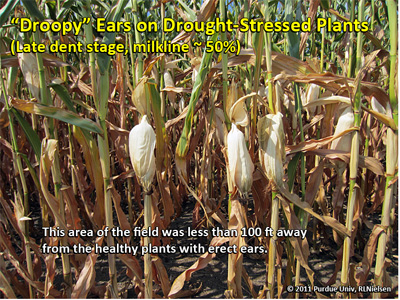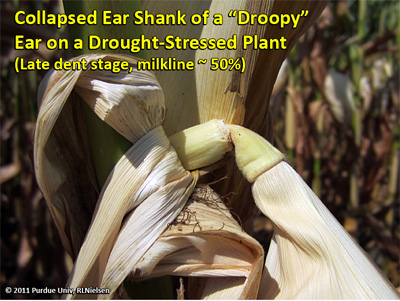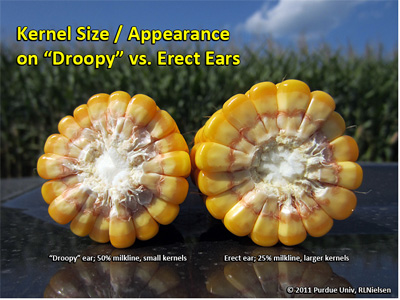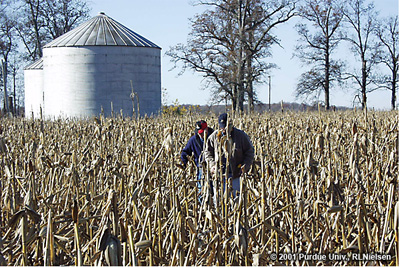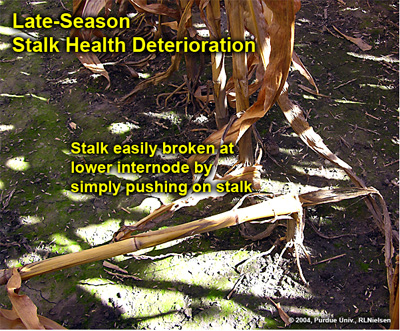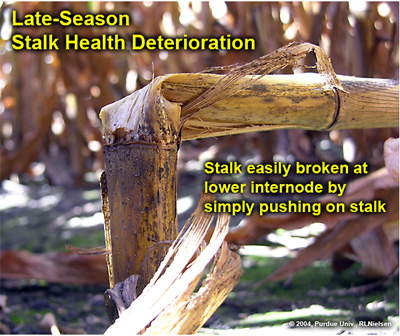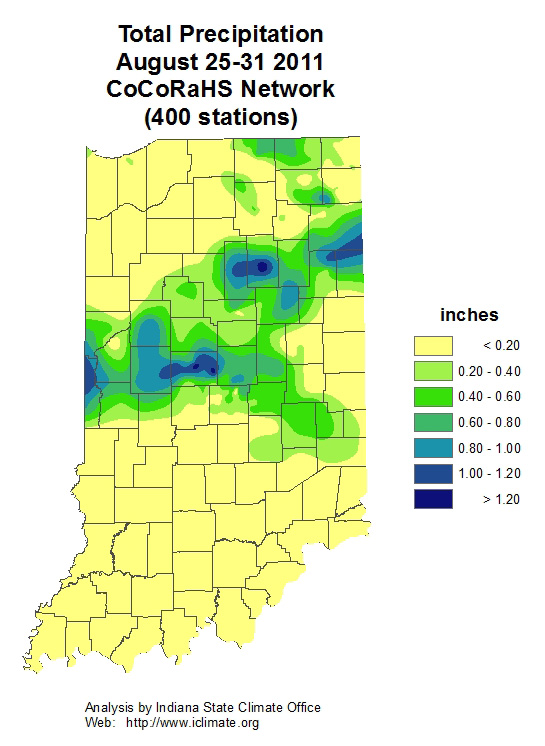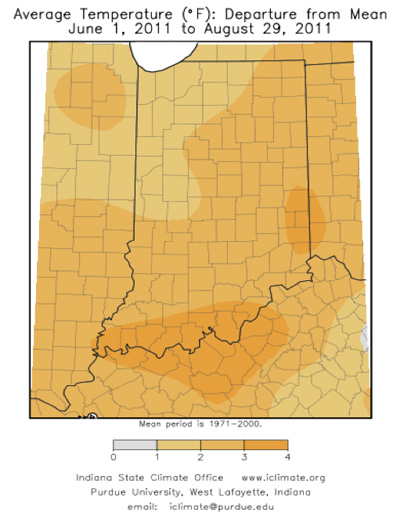Click here to see the Black Light Trap Catch Report
![]()
VIDEO: Effective Control of Big Lambsquarter – (Bill Johnson)
This video addresses the options available to farmers attempting to control lambsquarter that have gotten out of hand. The same could be said for many weed escapes, e.g., giant ragweed, this time of year. Special thanks to Glenn Nice for his contribution to this video.
![]()
Corn and Soybean Herbicides and Fall Cover Crop Establishment - (Bill Curran and Dwight Lingenfelter, Penn State Weed Specialists)
One of the more common questions that I have been asked recently is whether the corn or soybean herbicide program will pose a problem for seeding fall cover crops. If you look at the rotation crop restrictions for corn and soybean herbicides in the Agronomy Guide (Tables 2.2-17 and 2.4-15), you will see that many products limit rotation to alfalfa and/or clover as well as some of the small grains (and certainly vegetables). This is a good place to start when thinking about rotation to fall cover crops, but these tables are inadequate and these cash crop rotation restrictions may be due to the concern for herbicide residues accumulating in forage or feed rather than carryover injury, the focus of this article. If the crop is not going to be harvested and consumed by livestock or humans, then the primary concern is carryover injury and achieving an acceptable stand that provides the benefits of a fall or winter cover. Although few cover crops are listed in these Agronomy Guide tables or on herbicide labels, look for close relatives to get an idea of how certain species may succeed. For example, there is no listing for the legumes hairy vetch or winter pea in the Agronomy Guide or on most labels, but by looking at the alfalfa or clover restrictions you can "guesstimate" which herbicides may cause potential injury to related legumes. Covers such as tillage or daikon radish can be difficult to determine if herbicide residues will cause a problem. If herbicide labels list canola or other annual mustards as rotation crops, these might substitute well for radish. In general, products with a 4 month or less rotation restriction for the species of interest, close relative, or sensitive species (i.e. clovers) should pose little problem.
Some general guidelines. Avoid atrazine or simazine use if at all possible in corn if sensitive crops species and particularly legumes or annual ryegrass will follow. If 1 lb./acre (1 qt) or less of atrazine or simazine has been spring applied, cereal rye and other cereals will likely be OK to establish in the fall for cover. For legumes and mustards like canola and daikon radish, 0.75 lb/acre (1.5 pt) or less may be OK. Atrazine and simazine will persist longer on higher pH soils (pH 7 or greater) or soils recently limed, so watch surface pH in particular. Table1 provides some persistence information for some commonly used corn and soybean herbicides. Not only is herbicide half-life important (the time it takes for 50% of the active ingredient to dissipate), but also soil availability. Herbicides with shorter half-lives are always less of a concern. In addition, species sensitivity can play a role if only a small amount of residue is necessary to cause injury. Until more research has been conducted on herbicide carryover and cover crop establishment, rely on cash crop rotation restrictions along with what we know about herbicide persistence and availability.
| Table 1. Typical herbicide rates, sensitive species, half-life, and potential for carryover injury to sensitive crops (carryover potential based on half-lives and soil availability). | ||||
| Herbicide | Normal Rate/Acre | Sensitive Species | Half Life (Days)1 | Carryover Potential |
| Accent | 2/3 oz | broadleafs + grass | 21 | Low |
| Assure/Targa | 8 oz | grass | 60 | Low |
| Atrazine | 1 lb | broadleafs + grass | 60 | Moderate |
| Authority | 4 oz | broadleafs | 32-302 | Moderate |
| Balance Pro | 2 fl oz | broadleafs + grass | 50-150 | Moderate |
| Callisto | 6 fl oz | broadleafs | 5-32 | Moderate |
| Classic | 2 oz | broadleafs | 40 | Moderate |
| Dual II Mag | 1.67 pt | broadleafs + grass | 15-50 | Low |
| FirstRate | 0.33 oz | broadleafs | 8-33 | Low |
| Harmony | 1/8 oz | broadleafs | 12 | Low |
| Harness | 2 pt | broadleafs + grass | 10-20 | Low |
| Impact | 0.75 fl oz | broadleafs + grass | 14 | Low |
| Laudis | 3 fl oz | broadleafs + grass | 14 | Low |
| Outlook | 16 fl oz | broadleafs + grass | 20 | Low |
| Peak | 1 oz | broadleafs | 9-152 | Moderate |
| Permit | 2/3 oz | broadleafs | 9-27 | Low |
| Prowl H2O | 3 pt | broadleafs + grass | 44 | Low |
| Pursuit | 4 fl oz | broadleafs + grass | 60-90 | Moderate |
| Raptor | 5 fl oz | broadleafs + grass | 20-30 | Low |
| Reflex | 1.5 pt | broadleafs | 100 | Moderate |
| Resolve | 2 oz | broadleafs + grass | 2-4 | Low |
| Select | 10 oz | broadleafs | 3 d | Low |
| Sencor | 0.33 lb | broadleafs + grass | 14-60 | Low |
| Sharpen | 3 fl oz | broadleafs | 7-35 | Low |
| Simazine | 1 lb | broadleafs + grass | 60 d | Moderate |
| Stinger | 5 oz | broadleafs | 40 | Moderate |
| Valor | 2.5 oz | broadleafs | 12-20 | Low |
| 1Herbicide half-life estimates derived from the WSSA Herbicide Handbook, 2007 or other scientific literature. | ||||
![]()
Are Your Ears (of corn) Sagging? – (Bob Nielsen)
Ears of corn normally remain erect until some time after physiological maturity has occurred (black layer development), after which the ear shanks eventually collapse and the ears decline or "droop" down. In recent weeks, corn field connoisseurs have reported droopy ears in drought-stressed fields that have not yet reached physiological maturity.
Droopy ears are cute on certain breeds of dogs, but droopy ears on corn plants prior to physiological maturity are a signal that grain fill has slowed or halted. Premature ear declination (the fancy term for this problem) results in premature black layer formation, lightweight grain, and ultimately lower grain yield per acre.
What Causes Droopy Ears? The most common contributing factor seems to be severe drought stress that extends late into the grain filling period. The "droopy" symptom suggests a loss of turgidity in the ear shank with stress, possibly combined with some cannibalization of the ear shank similar to what can occur with the stored reserves of the main stalk. Eventually, the ear shank collapses and the ear droops down.
Erect ears on healthy plants
In hybrids without the Bt-corn borer trait, collapsed ear shanks can also result from extensive tunneling by European corn borer larvae. Such tunneling weakens the ear shank, allowing it to collapse, and can ultimately also cause the ear to literally drop from the plant.
Droopy ears on drought-stressed plants
Droopy ears on a drought-stressed plant
Impact on Yield? Remember that the ear shank is the final "pipeline" for the flow of photosynthates into the developing ear. An ear shank that collapses prior to physiological maturity will greatly restrict, if not totally prevent, the completion of grain fill for that ear and will likely cause premature black layer development in the grain. If the droopy ears you've looked have not yet black layered, they soon will.
The timing of the onset of the collapsed ear shanks determines the magnitude of the expected yield loss. If grain fill were totally shut down at the full dent stage of grain development (milk line barely visible at dent of kernels), the yield loss would be as much as 40 percent. If grain fill were totally shut down at the late dent stage of grain development (milk line halfway between dent and tip), yield losses for the affected ears would equal about 12 percent.
Collapsed ear shank of a droopy ear on a drought-stressed plant
Kernel size/appearance on droopy vs erect ears
Multiplying the percentage of affected ears in a field by the estimated yield loss per ear will give you an estimate of whole field loss. For example, if ten percent of the field contained plants whose ears drooped prematurely at the late dent stage, whole field loss would be estimated at 1.2 percent (10 percent of the ears multiplied by 12 percent yield loss per ear).
![]()
Stress During Grain Fill: A Harbinger of Stalk Health Problems – (Bob Nielsen)
Harbinger. [hahr-bin-jer] Anything that foreshadows a future event; omen; sign: Frost is a harbinger of winter.
Dictionary.com.Dictionary.com.Unabridged (v 1.1). Random House, Inc.
http://dictionary.reference.com/browse/harbinger (accessed: September 01, 2008).
During the grain filling period of corn, developing kernels become a significant photosynthetic "sink" for the products of photosynthesis and respiration. Corn plants prioritize the movement of these photosynthates to the kernels, even at the expense of not maintaining the cellular health of the stalk, leaves, and roots.
The primary effect of severe stress on a corn plant is a reduction in photosynthetic rates. When photosynthetic capacity decreases significantly during grain fill, plants often respond by remobilizing stored carbohydrates from stalk and leaf tissues to supply the intense physiological demand by the developing grain on the ears. In addition to physically weakening the stalk of plants, remobilization of stored carbohydrates and/or the consequent lower cellular maintenance of root and stalk tissues increases the susceptibility of the plant to root and stalk rots.
NOTE: Even if significant stalk rot does not develop in such stressed plants, loss of structural stalk integrity itself greatly increases the risk of stalk breakage.
Fields at higher risk for weakened stalks and stalk rot development will be those where plants have managed to set fairly decent ears, but have experienced severe stress during grain fill. Common photosynthetic stresses that occur during grain filling in Indiana include drought stress, nitrogen deficiency, defoliation by hail, and foliar leaf diseases. The effects of dry weather during August on corn stalk health are accentuated where compacted soils restricted root growth earlier in the season or on sandy soils with minimal water-holding capacity.
Two men checking a corn field
Late-season stalk health deterioration
Growers should monitor stressed fields in late August and early September for compromised stalk strength or the development of severe stalk rots and adjust their harvest schedules accordingly to harvest these fields early in the season to avoid the consequences of severe stalk lodging. In years where crop development is delayed, like in 2009, stalk quality problems often are not apparent until mid- to late September.
Late season stalk health deterioration
Pinch lower internode to assess stalk quality
Late season stalk health deterioration
Late season stalk health deterioration
Stalk breakage itself is obviously easy to spot when scouting a field. However, compromised stalks may stand unnoticed until that October storm front passes through and brings them to their proverbial knees. The simplest techniques for identifying suspect stalk quality involve either pushing on stalks to see whether they will collapse or bending down and pinching the lower stalk internodes to see whether they collapse easily between your fingers. Sometimes the mere act of pushing stalks out of your way as you walk from one row of corn to another is enough force to collapse weakened stalks.
TIP: Bending down repeatedly to pinch lower stalk internodes qualifies as an aerobic exercise.
Fields and/or hybrids at high risk of stalk breakage should be harvested as early as possible to minimize the risk of significant mechanical harvest losses. Recognize that hybrids can vary greatly for late-season stalk quality even if grown in the same field due to inherent differences for late-season plant health or resistance against carbohydrate remobilization when stressed during grain fill.
Another side-effect of late-season stress during grain fill is the greater risk of premature kernel black layer formation. In 2009, foliar diseases like gray leaf spot (Cercospora zeae-maydis) and northern corn leaf blight (Exserohilum turcicum) developed late in the season (some say, exploded) and destroyed much if not all of the green leaf tissue before the grain had matured. Such destruction of green leaf tissue, in addition to encouraging the remobilization of stored carbohydrates from the lower stalks, also predisposes the grain to premature kernel black layer formation. The consequences of premature kernel black layer include not only lower grain yield, but also the likelihood of lower test weight grain.
Related Reading
Jackson, Tamra. 2009. Stalk Rots Already a Problem in Some Nebraska Fields. CropWatch Newsletter. Univ. of Nebraska. [online] http://cropwatch.unl.edu/web/cropwatch/archive?articleId=1499298. [URL accessed Aug 2011].
Lee, Chad . 2007. Weak Corn Stalks from Drought. Corn & Soybean News, Univ. of Kentucky. [online] http://www.uky.edu/Ag/CornSoy/cornsoy7_7.htm [URL accessed Aug 2011].
Mills, Dennis, Pierce Paul, and Peter Thomison. 2006. Corn Stalk Rot: A Disease Caused by Several Different Fungi. C.O.R.N. Newsletter, Ohio State Univ. [online] http://corn.osu.edu/newsletters/2006/article?issueid=155&articleid=932 [URL accessed Aug 2011].
Nielsen, R.L. (Bob). 2008. Grain Fill Stages in Corn. Corny News Network, Purdue Univ. [online] http://www.kingcorn.org/news/timeless/GrainFill.html [URL accessed Aug 2011].
Nielsen, R.L. (Bob) 2009. Effects of Stress During Grain Filling in Corn. Corny News Network, Purdue Univ. [online] http://www.kingcorn.org/news/timeless/GrainFillStress.html [URL accessed Aug 2011].
Shaner, G. and D. Scott. 1998. Stalk Rots of Corn. Purdue Univ. Extension Publication BP-59. Available online at http://www.ces.purdue.edu/extmedia/BP/BP-59.pm65.pdf [URL accessed Aug 2011].
Thomison, Peter, Pierce Paul, and Dennis Mills. 2008. Dry Weather May Lead to Stalk Lodging Problems in Corn. C.O.R.N. Newsletter, Ohio State Univ. [online] http://corn.osu.edu/newsletters/2008/article?issueid=248&articleid=1559 [URL accessed Aug 2011].
Vincelli, Paul. 2004. Factors That Could Enhance Stalk Rots in Corn. Kentucky Pest News (Aug 2). Univ. of Kentucky. Available online at http://www.uky.edu/Agriculture/kpn/kpn_04/pn040802.htm#corrot [URL accessed Aug 2011].
![]()


